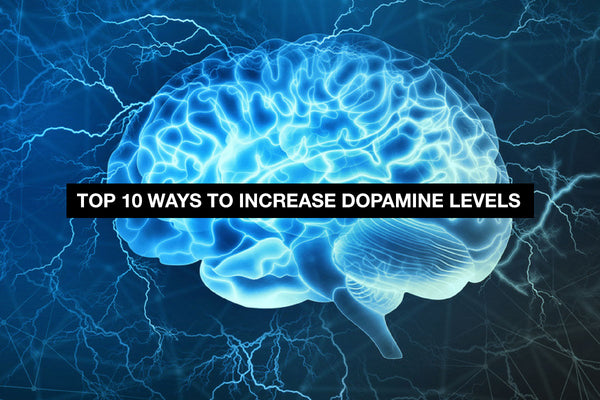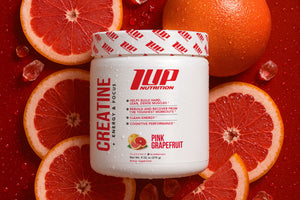Dopamine is one of the major neurotransmitters (chemical messengers in the body) that impacts mood, motivation, focus, movement control, and reward. Plus, recent studies note that dopamine can play a vital role in the decision-making process, which can greatly impact our chances of being successful in work and life in general.[1]
Basically, without dopamine, you don’t have the drive to do anything.
You also don’t have the motor skills needed to get work done, nor would you be able to experience the sensations of satisfaction or pleasure from getting tasks completed (assuming you even get started on them in the first place).
To say that dopamine is vital to health, wellness, and productivity would be a gross understatement.
Dopamine is absolutely essential to your mental well being as well as your ability to engage in even the most mundane of activities, like walking to the mailbox.
Low levels of dopamine are associated with feelings of decreased motivation and enthusiasm for activities/experiences that usually bring about feelings of joy and/or excitement.[2]
Fortunately, there are a great many ways to naturally boost dopamine levels in the body.
Here, we present our top 10 ways to increase dopamine levels.
Top 10 Ways to Increase Dopamine Levels
Exercise
There’s seemingly nothing exercise doesn’t benefit.
It improves measures of cardio-metabolic health, body composition, sleep, and mood.
Exercise also serves as a great way to boost productivity and creativity all the while helping crush stress and anxiety.
One of the main reasons exercise helps boost mood and outlook is because it increases dopamine levels.
In fact, even as little as 10-20 minutes of physical activity can boost dopamine levels in the brain.[3]
Further, exercise also increases the number of dopamine receptors in the brains.[4]
It’s also worth mentioning that “exercise” in this sense can include multiple types of physical activity -- cardio, resistance-training, and even yoga have been shown to significantly increase dopamine levels.[5]
You might also be interested to know that regular exercise also benefits individuals suffering from Parkinson’s disease, a neurological disorder characterized by the dying off of dopamine-producing brain cells, which impugns the brain’s ability to control body movements.[6]
Consume a High Protein Diet
The body synthesizes dopamine from the amino acid tyrosine.
The body can create tyrosine from the essential amino acid L-phenylalanine and it can also obtain tyrosine from various high-protein foods, such as meat, fish, eggs, dairy (such as whey protein), beans, nuts, and oats.[7]
Research indicates that consuming diets rich in both phenylalanine and tyrosine can help support increased dopamine production, which enhances mood, memory, motivation, and focus.[8,9]
At the same time, diets low in these two amino acids have shown to lead to low concentrations of dopamine.[10]
Moderate Intake of Saturated Fats
Fat -- at one time the most demonized and loathed of all macronutrients has experienced a renaissance in recent years thanks to the continued popularity of high-fat diets such as Paleo, Carnivore, and Keto.
Furthermore, recent research also indicates that dietary fat isn’t the macronutrient ne’er-do-well it was previously thought to be by Ancel Keyes and company.[11,12]
Still, while fat may not be as hazardous to our cardio-metabolic health as previously thought, that doesn’t mean you have carte blanche to consume as much as you want without consequences.
Animal studies indicate that high intakes of saturated fat may impede dopamine signaling in the brain.[13,14]
Researchers have hypothesized that diets high in saturated fat may increase systemic inflammation, which causes unfavorable changes to the dopamine system.
However, more human studies are needed to confirm whether saturated fats are causative of low dopamine or it’s merely an association and other factors are at play.
Regardless, high-protein diets supply your body with sufficient levels of tyrosine and phenylalanine to support optimal dopamine production.
Listen to Great Music
Music can bring up many emotions -- it can make us happy, break us out of a funk, or help us work through times of melancholy.
One of the reasons that music can make us feel such a wide spectrum of emotions is that it triggers the release of several different types of neurotransmitters in the body, including serotonin and dopamine.
Research have demonstrated that listening to music increases activity in regions of the brain, such as the amygdala, nucleus accumbens, hypothalamus, and hippocampus, brain, which contain high concentrations of dopamine receptors.[15]
Another study noted that listening to music increased dopamine levels by 9% when individuals listened to instrumental music.[16]
Based on these findings researchers have even begun to investigate the use of music as an adjunct treatment in individuals with Parkinson’s disease.
Now, you might be wondering what type of music boosts dopamine. Is it any type of music, or only certain types.
Well, research to date has predominantly used instrumental-only music. However, any upbeat, happy, or motivational music is likely to boost dopamine levels. Some types just may do it more than others.
Get Outdoors
These days we’re stuck inside more than ever be it due to work, lifestyle choices, or government mandate.
And, while you might be #crushingit on your Netflix binging, you’re also sabotaging your vitamin D intake as well as your dopamine levels.
Seasonal affective disorder (SAD) is a condition affecting some 10 million people each year. SAD occurs when people feel sad or depressed when they do not get enough sunlight. Typically, this occurs during the winter months.
Research has clearly shown that limited sunlight exposure results in depressed levels of several mood-boosting neurotransmitters, including dopamine. Fortunately, this depression can be alleviated by exposure to the sun.[17,18]
As you’re likely aware, it is possible to spend too much time in the sun, i.e. getting a sunburn. As with all things in life, moderation is key.
Get Enough Sleep
We’ve said it countless times before, and we’ll continue to say it ad infinitum.
You NEED to get enough sleep each and every night.
Sleep affects your mood, decision making, recovery, and performance, both mental and physical. Sleep quality also impacts your nutrition choices and how your body utilizes and stores those nutrients.
Research finds that when individuals are sleep deprived, dopamine receptor availability is significantly decreased the morning after.[19]
In addition to affecting mood, reward, and motivation, dopamine also supports wakefulness.
With less dopamine in the brain (as a result of poor sleep), concentration, coordination, and performance are also negatively impacted.[20]
In other words, if you want to be functioning at your best each day, you need to get enough sleep each night.
“Enough” sleep is considered 7–9 hours of sleep every night per the National Sleep Foundation.
Establishing a nighttime routine, cutting off caffeine intake by 3PM, and avoiding blue light exposure two hours before bed can help facilitate a great night’s sleep.
You can also try taking a nighttime sleep and relaxation aid, such as Recharge PM Burner or 1UP Beauty Dream, which were formulated to promote feelings of calm relaxation and sedation while also reducing feelings of stress and anxiety (which can disrupt sleep).
Consume a Healthy Diet
Gut health has been the subject of intense research the past several years as we learn the gut impacts everything from mood to cognitive function to immune function.
You might be interested to know that ~90% of the body’s serotonin is made in the gut, and it also contains a large number of cells that produce dopamine, too.[21]
But, that’s not all, the bacteria in your gut are also capable of creating dopamine.[22]
This has led people to focus even more on their nutrition, consuming foods that support and reinforce the health of the gut microbiome.
To support gut health, you need to focus on foods that feed the bacteria in your gut as well as foods that supply your gut directly with healthy bacteria.
This is done through a combination of fiber-rich foods (prebiotics) and probiotics.
Prebiotics are the non-digestible portion of plant foods that serve as “food” for gut bacteria.[23] Prebiotic fibers can be found in many foods you’re likely already eating -- fruits, vegetables, whole grains, nuts, and seeds.
Probiotics are live strains of good bacteria and yeasts that support the digestive system. Fermented foods are particularly rich in probiotics. Examples include yogurt, kefir, sauerkraut, pickles, kimchi, and kombucha.
Meditate
Meditation is a centuries-old practice in which you focus inward on a single object or thought, clearing your mind of the noise, and leaving the worries of the world behind.
This helps to train attention and awareness, and it can help individuals achieve a clear, calm and stable state of being.
Meditation requires no equipment. It can be done sitting, standing, or walking.
The practice has long been regarded as a way to improve mental health and reduce stress and anxiety. Newer research indicates that this may be due to meditation having a beneficial impact on dopamine levels in the brain.
One study in particular found that experienced meditators experienced a 64% increase in dopamine levels after 60 minutes of meditation.[24]
Get a Massage
Sitting hunched over a desk all day can leave us feeling tight, immobile, and cranky. Hard workouts also create muscle soreness and stiffness.
Both of these can have you feeling a bit on edge.
Fortunately, one of the best things you can do to alleviate these aches and pains of work and working out is to get a massage.
As an added bonus, getting a massage can also boost your dopamine production.
Research finds that massage therapy can increase dopamine levels by an average of 31%. The same study also found massages increased serotonin levels by an average of 28% and significantly decreased cortisol levels, indicating massages have a stress-alleviating effect.[25]
Supplement Smarter
To synthesize dopamine, the body relies on a host of vitamins, minerals, enzymes, and amino acids.
Above, we discussed the importance of two amino acids tyrosine and phenylalanine. Those amino acids can be obtained from high-protein foods, and they can also be supplemented directly, such as from pre workout supplements or amino acid supplements.
Other important micronutrients required for the production of dopamine include niacin, folate (folic acid), and vitamin B6.[27,28]
Deficiencies in any one of these nutrients can impair dopamine creation in the brain.[26]
You might also be interested to know that the “backbone” of all pre workout supplements and thermogenic fat burners, caffeine, increases dopamine release and dopamine receptor availability in the brain.[29,30]
This is one of the reasons having a cup of coffee, or scoop of pre workout, can boost energy, mood, and motivation.
In addition to proper nutrition, several other supplements have been linked to increased dopamine levels, but thus far, research is limited to animal studies.
Takeaway
Dopamine is a critical neurotransmitter in the body affecting mood, motivation, reward, pleasure, decision making, and movement.
Living a healthy lifestyle (stress management, sleep, exercise) and eating a well-rounded, high-protein diet can help ensure you’re supplying your body with everything it needs to sustain optimal dopamine production.
A number of supplements may also help naturally boost dopamine levels, helping to improve mood and performance. Noteworthy supplements include L-Dopa, Tyrosine, Phenylalanine, vitamin B6, and Folic acid.
References
- Treadway MT, Buckholtz JW, Cowan RL, et al. Dopaminergic Mechanisms of Individual Differences in Human Effort-Based Decision-Making. J Neurosci. 2012;32(18):6170 LP-6176.
- Chong, T. T.-J., & Husain, M. (2016). The role of dopamine in the pathophysiology and treatment of apathy. Progress in Brain Research, 229, 389–426. https://doi.org/10.1016/bs.pbr.2016.05.007
- Hansen, C. J., Stevens, L. C., & Coast, J. R. (2001). Exercise duration and mood state: how much is enough to feel better? Health Psychology : Official Journal of the Division of Health Psychology, American Psychological Association, 20(4), 267–275. https://doi.org/10.1037//0278-6133.20.4.267
- Meeusen R, Piacentini MF, De Meirleir K. Brain microdialysis in exercise research. Sports Med. 2001;31(14):965–983. doi:10.2165/00007256-200131140-00002
- Pal R, Singh SN, Chatterjee A, Saha M. Age-related changes in cardiovascular system, autonomic functions, and levels of BDNF of healthy active males: role of yogic practice. Age (Dordr). 2014;36(4):9683. doi:10.1007/s11357-014-9683-7
- Fisher BE, Li Q, Nacca A, et al. Treadmill exercise elevates striatal dopamine D2 receptor binding potential in patients with early Parkinson's disease. Neuroreport. 2013;24(10):509–514. doi:10.1097/WNR.0b013e328361dc13
- Fernstrom JD, Fernstrom MH. Tyrosine, phenylalanine, and catecholamine synthesis and function in the brain. J Nutr. 2007;137(6 Suppl 1):1539S–1548S. doi:10.1093/jn/137.6.1539S
- Colzato LS, de Haan AM, Hommel B. Food for creativity: tyrosine promotes deep thinking. Psychol Res. 2015;79(5):709–714. doi:10.1007/s00426-014-0610-4
- Kühn S, Düzel S, Colzato L, et al. Food for thought: association between dietary tyrosine and cognitive performance in younger and older adults. Psychol Res. 2019;83(6):1097–1106. doi:10.1007/s00426-017-0957-4
- Montgomery AJ, McTavish SF, Cowen PJ, Grasby PM. Reduction of brain dopamine concentration with dietary tyrosine plus phenylalanine depletion: an [11C]raclopride PET study. Am J Psychiatry. 2003;160(10):1887–1889. doi:10.1176/appi.ajp.160.10.1887
- Liu AG, Ford NA, Hu FB, Zelman KM, Mozaffarian D, Kris-Etherton PM. A healthy approach to dietary fats: understanding the science and taking action to reduce consumer confusion. Nutr J. 2017;16(1):53. Published 2017 Aug 30. doi:10.1186/s12937-017-0271-4
- Forouhi NG, Krauss RM, Taubes G, Willett W. Dietary fat and cardiometabolic health: evidence, controversies, and consensus for guidance. BMJ. 2018;361:k2139. Published 2018 Jun 13. doi:10.1136/bmj.k2139
- Cone JJ, Chartoff EH, Potter DN, Ebner SR, Roitman MF. Prolonged high fat diet reduces dopamine reuptake without altering DAT gene expression. PLoS One. 2013;8(3):e58251. doi:10.1371/journal.pone.0058251
- Geiger BM, Haburcak M, Avena NM, Moyer MC, Hoebel BG, Pothos EN. Deficits of mesolimbic dopamine neurotransmission in rat dietary obesity. Neuroscience. 2009;159(4):1193–1199. doi:10.1016/j.neuroscience.2009.02.007
- Koelsch S. Brain correlates of music-evoked emotions. Nat Rev Neurosci. 2014;15(3):170–180. doi:10.1038/nrn3666
- Salimpoor VN, Benovoy M, Larcher K, Dagher A, Zatorre RJ. Anatomically distinct dopamine release during anticipation and experience of peak emotion to music. Nat Neurosci. 2011;14(2):257–262. doi:10.1038/nn.2726
- Cawley EI, Park S, aan het Rot M, et al. Dopamine and light: dissecting effects on mood and motivational states in women with subsyndromal seasonal affective disorder. J Psychiatry Neurosci. 2013;38(6):388–397. doi:10.1503/jpn.120181
- Neumeister A, Konstantinidis A, Praschak-Rieder N, et al. Monoaminergic function in the pathogenesis of seasonal affective disorder. Int J Neuropsychopharmacol. 2001;4(4):409–420. doi:10.1017/S1461145701002644
- Volkow ND, Tomasi D, Wang GJ, et al. Evidence that sleep deprivation downregulates dopamine D2R in ventral striatum in the human brain. J Neurosci. 2012;32(19):6711–6717. doi:10.1523/JNEUROSCI.0045-12.2012
- Volkow ND, Wang GJ, Kollins SH, et al. Evaluating dopamine reward pathway in ADHD: clinical implications [published correction appears in JAMA. 2009 Oct 7;302(13):1420]. JAMA. 2009;302(10):1084–1091. doi:10.1001/jama.2009.1308
- Rao M, Gershon MD. The bowel and beyond: the enteric nervous system in neurological disorders. Nat Rev Gastroenterol Hepatol. 2016;13(9):517–528. doi:10.1038/nrgastro.2016.107
- Wall R, Cryan JF, Ross RP, Fitzgerald GF, Dinan TG, Stanton C. Bacterial neuroactive compounds produced by psychobiotics. Adv Exp Med Biol. 2014;817:221–239. doi:10.1007/978-1-4939-0897-4_10
- Slavin J. Fiber and prebiotics: mechanisms and health benefits. Nutrients. 2013;5(4):1417–1435. Published 2013 Apr 22. doi:10.3390/nu5041417
- Kjaer TW, Bertelsen C, Piccini P, Brooks D, Alving J, Lou HC. Increased dopamine tone during meditation-induced change of consciousness. Brain Res Cogn Brain Res. 2002;13(2):255–259. doi:10.1016/s0926-6410(01)00106-9
- Field T, Hernandez-Reif M, Diego M, Schanberg S, Kuhn C. Cortisol decreases and serotonin and dopamine increase following massage therapy. Int J Neurosci. 2005;115(10):1397–1413. doi:10.1080/00207450590956459
- Guilarte TR. Effect of vitamin B-6 nutrition on the levels of dopamine, dopamine metabolites, dopa decarboxylase activity, tyrosine, and GABA in the developing rat corpus striatum. Neurochem Res. 1989;14(6):571–578. doi:10.1007/bf00964920
- Homma, D., Katoh, S., Tokuoka, H., & Ichinose, H. (2013). The role of tetrahydrobiopterin and catecholamines in the developmental regulation of tyrosine hydroxylase level in the brain. Journal of Neurochemistry, 126(1), 70–81. https://doi.org/10.1111/jnc.12287
- Kennedy DO. B Vitamins and the Brain: Mechanisms, Dose and Efficacy--A Review. Nutrients. 2016;8(2):68. Published 2016 Jan 27. doi:10.3390/nu8020068
- Volkow ND, Wang GJ, Logan J, et al. Caffeine increases striatal dopamine D2/D3 receptor availability in the human brain. Transl Psychiatry. 2015;5(4):e549. Published 2015 Apr 14. doi:10.1038/tp.2015.46
- Solinas, M., Ferré, S., You, Z.-B., Karcz-Kubicha, M., Popoli, P., & Goldberg, S. R. (2002). Caffeine Induces Dopamine and Glutamate Release in the Shell of the Nucleus Accumbens. The Journal of Neuroscience, 22(15), 6321 LP – 6324. https://doi.org/10.1523/JNEUROSCI.22-15-06321.2002






